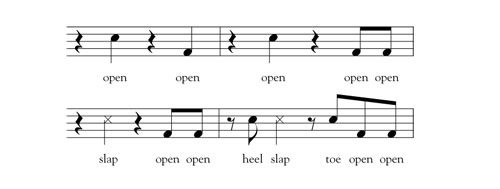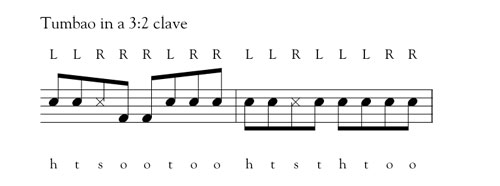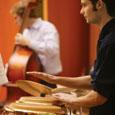Nothing adds to the groove of a rhythm section like a well-played conga part. The variety of sounds and intricate rhythmic phrases will add depth to the music.
Congas come in three sizes. The smallest drum, usually 11" in diameter, is called a quinto and is placed on the player’s left. The conga is 11.75" in diameter and is on the right. Some players will add the 12.5" tumba drum, but the most common setup is to use the quinto and conga. The drums may be placed on a stand or rest on the floor, although a stand makes it easier to get a good bass sound.
The quinto should be tuned a perfect fourth above the conga, and the tumba should be tuned a minor third below the conga. Tune the drums in a cross pattern.
Strokes
The most basic conga sound is called an open tone because the drum is allowed to ring after it is hit. The open sound is played at the edge of the drum using the arm and wrist together with the fingers slightly apart. Each open stroke should consist of a simple up-and-down motion of the forearm and hand. Make a quick downward motion with the wrist as the forearm approaches the drum. All four fingers should hit the drum and immediately come off it so the sound is not muffled.
The bass tone is produced by the palm of the hand pushing into the drumhead. The fingers and thumb are relatively close together and the wrist bends upward so the drum is struck with the heel of the palm and the weight of the arm helps produce the sound. The hand should not rebound off the drum as quickly as for the open sound.
The slap tone is difficult to produce, and it takes quite a bit of practice to get consistent tones. The stroke is similar to the open sound, but a whip motion with the fingers is added right before the drum is struck. At the completion of the stroke the hand should be in an inverted V shape. The slap requires more finger strength than the open and bass tones. Slaps can be open or muted, in which the left hand mutes the drum while the right hand plays the slap.
The heel and toe strokes are softer filler sounds, played with a rocking motion in the left hand. Heel refers to the heel of the palm and toe refers to the fingertips. These strokes are played on the far side of the drum.
Patterns
A conga swing pattern can be as simple as open quinto on beat two and open conga on beat four, or it can be widely embellished. The quinto note on beat two can be changed to a muted slap with a heel right before it, and the beat four note can be changed to two eighth notes with a toe right before. The same pattern can be used for rock-style music by playing the eighth notes straight instead of swung.

The gallop pattern is also commonly used in rock charts.

To play the basic Latin pattern, called the tumbao, the conga player should understand the two-measure clave pattern. It is referred to as a 3:2 pattern when the measures are in this order and a 2:3 pattern when they are reversed.

The order of the measures in the clave pattern determines the order of the tumbao measures.

It is important for conga players to listen to recordings and watch videos to understand the sounds required. Although learning correct technique can be frustrating, a good conga sound can be a wonderful addition to an ensemble.
For performance examples, click the publications tab on the author’s website: bigdmusicinc.com.





